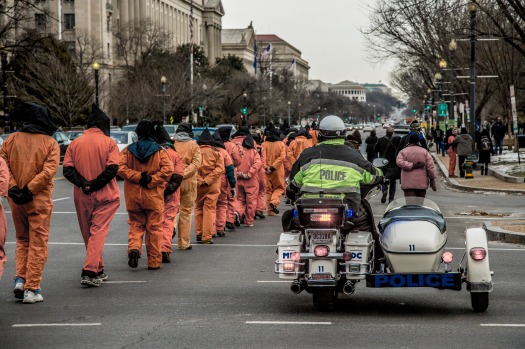
I’ve been going to Washington, DC every January since 2008 to join the Witness Against Torture community as they lift the voices of Guantanamo detainees in the streets and before the seats of power. This work has taught me gradually to approach a political problem through the humanity of its victims. The policy takes on flesh and bones through my own experience of another’s reality.
It all started that first time I came to a WAT action in DC in 2008. It was the 6th anniversary of the opening of Guantanamo’s prison on Jan. 11, 2002. Activists were suiting up in orange jumpsuits and black hoods to make a prisoner procession from the National Mall to the Supreme Court. I recall my fear as I made the decision to join the procession. Donning the prisoner garb right there in the center of political power that created these prisoners? What would it be like to put that hood over my head?
Luckily for me, it was not the thick, stifling hood the detainees themselves were forced to wear. Instead our hoods were made of a lightweight fabric that allowed us to dimly make out shapes. We could see where we were going and, with a little help from our procession guides, avoid stumbling.
While the hood did not recreate the detainee’s physical experience, it did indeed hint at the psychological experience. I was now anonymous. No one knew who I was. Now for a protester, anonymity could be convenient. Not so for the prisoner.
The detainees’ guards did not have to look at their faces. The guards did not see the suffering in the prisoners’ eyes when they were strapped to the floor of a C-130 transport plane for the long journey from Afghanistan to Guantanamo. Nor did soldiers see their sweating, terrified faces when the prisoners were shoved into cages in the blistering Cuban sun and made to kneel for hours on end. Most Americans still remember the iconic image of the hooded detainee standing on a box with wires protruding from his arms at Abu Ghraib. In all these examples, the hood served to hide the prisoner’s humanity. The hood carried a sinister connotation, and each hooded prisoner took on the threatening identity labeled “terrorist.” The deliberate dehumanization of the prisoners made it easier to heap tremendous abuse upon them.
Last June in Washington, I learned more about dehumanization at a panel titled Legalized Torture: From Guantanamo Bay to Rikers. Dr. Maha Hilal, executive director of the National Coalition to Protect Civil Freedoms, emphasized the role of dehumanization in producing torture. At Guantanamo, she told us, dehumanization took three forms: first, a cultural erasure, then a legal erasure, leading finally to the physical erasure that is torture. She emphasized that torture is part of a continuum, not a discrete act. Prior to torture, people are dehumanized to get the public conditioned to accept it and that becomes part of the torture itself.
I’m grateful to the Witness Against Torture community for its work to tell the stories of the prisoners at Guantanamo in a bid to restore their dignity and humanity before the American people. One of our artist members has created large canvas paintings each depicting the face of a particular prisoner. One of paintings was that of Tariq Ba Odah whom we displayed at the White House in the photo below. When his attorney showed Tariq this photo, he cried tears of joy and gratitude. So powerful was it to have his face restored, so to speak, and brought to the center of power.
Restoring the prisoner’s face is a first antidote to dehumanization and the evils it enables. I’m reminded again of Luke Nephew’s powerful spoken word performance in front of the Department of Justice on Jan. 11, 2011: There’s a Man Under That Hood.“